Welcome to the Nanopore Community
Order MinION devices and consumables
Visit vwr.comUltra-Long DNA Sequencing Kit V14 (SQK-ULK114)
Version for device: MinION
Introduction to the protocol
Overview of the protocol
Overview of the protocol
-
Introduction to the Ultra-Long DNA Sequencing Kit protocol (SQK-ULK114)
This protocol describes the complete workflow from extracting gDNA from frozen tissue or purified cells from whole blood to the sequencing of ultra-high molecular weight (uHMW) gDNA using the Ultra-Long DNA Sequencing Kit (SQK-ULK114). We have also included the procedure to isolate white blood cells (WBCs) from whole blood and how to quantify gDNA developed by Paul A ‘Giron’ Koetsier & Eric J Cantor, 2021.
We have used the NEB Monarch® HMW DNA Extraction Kit for Tissue (cat # T3060) to extract the uHMW gDNA for both input types when developing this protocol. Alternative kits are available from NEB which are specifically designed for the extraction from blood and cells. However, they have not been validated by Oxford Nanopore Technologies.
Per reaction, there is enough library generated for multiple consecutive loads onto a flow cell to increase output. To load a library six times on a MinION/GridION flow cell, a flow cell wash is required to recover channels.
Steps in the sequencing workflow:
Prepare for your experiment
You will need to:- If working with whole blood, isolate white blood cells. If working with frozen tissue, isolate cells from the tissue
- Extract your uHMW gDNA
- Quantify your sample
- Ensure you have your sequencing kit, the correct equipment and third-party reagents
- If not already installed, download the software for acquiring and analysing your data
- Check your flow cell(s) to ensure it has enough pores for a good sequencing run
Library preparation
You will need to:- Tagment your DNA using a diluted fragmentation mix
- Attach Rapid Adapters to the DNA ends
- Clean-up your sample by precipitating your DNA and elute overnight
- Prime the flow cell and load your DNA library into the flow cell
Sequencing and analysis
You will need to:- Start a sequencing run using the MinKNOW software, which will collect raw data from the device and convert it into basecalled reads
- Optional: Start the EPI2ME software and select a workflow for further analysis
-
Flow cell loading and flushing
The Ultra-Long DNA Sequencing Kit (SQK-ULK114) protocol generates viscous DNA which can affect flow cell loading. We have modified the flow cell loading steps to take account for this. Please take care and follow the steps carefully to avoid damaging the flow cell.
To increase output, we recommend loading an ultra-long library three times per flow cell. A flow cell wash using the Flow Cell Wash Kit (EXP-WSH004) is required between each subsequent library load to recover channels. To run a second library straight away, please follow the modified method in this protocol: To run another library of ultra-long DNA on a MinION/GridION flow cell straight away.
-
Best practice for handling uHMW gDNA
When mixing, we recommend using wide-bore pipette tips to mix the full volume of a sample to ensure thorough mixing whilst minimising mechanical shearing of long fragments.
To preserve longer DNA, mix slower and more gently. Vortexing on low speeds may also be used at the expense of very long fragments.
While precautions should be taken to ensure that DNA fragment lengths are preserved, there should be no compromise to ensuring that reagents are thoroughly mixed with DNA. Insufficient mixing will lead to reduced read length and output.
For further information, please refer to the troubleshooting section.
Equipment and consumables
Equipment and consumables
- Materials
-
- Ultra-Long DNA Sequencing Kit V14 (SQK-ULK114)
- Monarch® HMW DNA Extraction Kit for Tissue (New England Biolabs, T3060)
- Flow Cell Wash Kit (EXP-WSH004)
- Consumables
-
- MinION and GridION Flow Cell
- Isopropanol, 100% (Fisher, 10723124)
- Ethanol, 100% (e.g. Fisher, 16606002)
- Qubit dsDNA BR Assay Kit (Invitrogen, Q32850)
- Qubit™ Assay Tubes (Invitrogen, Q32856)
- Bovine Serum Albumin (BSA) (50 mg/ml) (e.g Invitrogen™ UltraPure™ BSA 50 mg/ml, AM2616)
- 1.5 ml Eppendorf DNA LoBind tubes
- 2 ml Eppendorf DNA LoBind tubes
- 5 ml Eppendorf DNA LoBind tubes
- 15 ml Falcon tubes
- Equipment
-
- MinION or GridION device
- MinION and GridION Flow Cell Light Shield
- Thermal cycler or heat block
- Thermomixer set at 56°C (suitable for 1.5 ml, 2 ml and 5 ml tubes)
- Vortex mixer
- Microfuge
- Wide-bore pipette tips
- P1000 pipette and tips
- P200 pipette and tips
- Qubit fluorometer (or equivalent)
- Ice bucket with ice
- Timer
-
For this protocol, you will need to extract gDNA from 6 million cells in 40 µl PBS before starting the library preparation.
This protocol has been developed using the NEB Monarch® HMW DNA Extraction Kit for Tissue (cat # T3060). Alternative kits are available from NEB which are specifically designed for the extraction from blood and cells. However, they have not been validated by Oxford Nanopore Technologies.
This method has been validated for use on the following inputs:
- 6 million white blood cells isolated from 1.6 ml blood (bovine), using RBC Lysis Solution (QIAGEN, cat # 158904)
- 6 million cells isolated from 1 g frozen tissue, using pluriSelect Cell Straining equipment.
-
Check your flow cell
We highly recommend that you check the number of pores in your flow cell prior to starting a sequencing experiment. This should be done within 12 weeks of purchasing for MinION/GridION/PromethION or within four weeks of purchasing Flongle Flow Cells. Oxford Nanopore Technologies will replace any flow cell with fewer than the number of pores in the table below, when the result is reported within two days of performing the flow cell check, and when the storage recommendations have been followed. To do the flow cell check, please follow the instructions in the Flow Cell Check document.
Flow cell Minimum number of active pores covered by warranty Flongle Flow Cell 50 MinION/GridION Flow Cell 800 PromethION Flow Cell 5000 -
Ultra-Long DNA Sequencing Kit (SQK-ULK114) contents
We had previously uncovered an issue with the Precipitation Stars (PS) found in the SQK-ULK114 kits and removed their use from the method to prevent any potential issues.
We have since improved our manufacturing and internal validation processes of the Precipitation Stars (PS) and are now in the position to reintroduce their use with the SQK-ULK114 Kits.
Kit format with improved precipitation stars that can be used:
Batch ULK114.30.0001 or newer
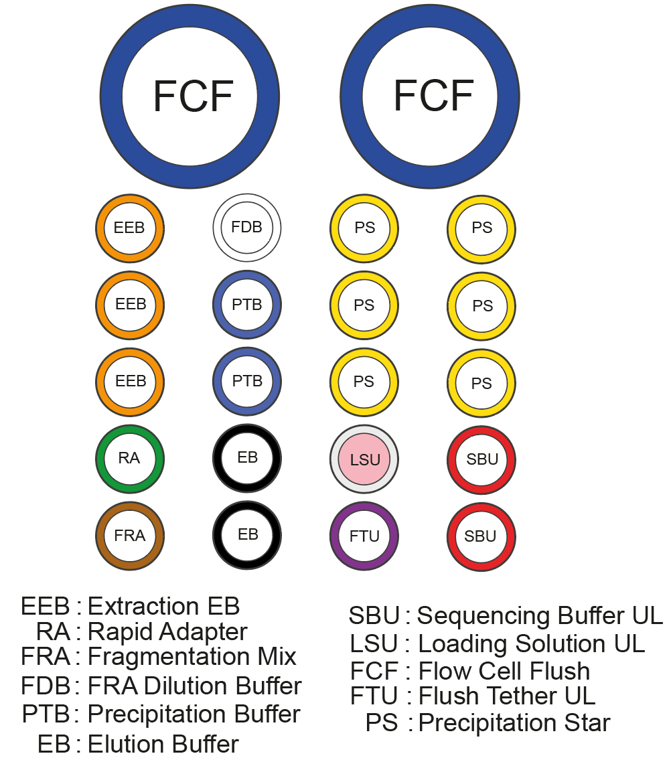
Name Acronym Cap colour Number of vials Fill volume per vial (µl) Rapid Adapter RA Green 1 40 Fragmentation Mix FRA Amber 1 50 FRA Dilution Buffer FDB Clear 1 1,600 Elution Buffer EB Black 2 1,500 Extraction EB EEB Orange 3 1,700 Sequencing Buffer UL SBU Red 2 1,000 Loading Solution UL LSU White cap, pink label 1 200 Flush Tether UL FTU Purple 1 600 Flow Cell Flush FCF Blue 2 15,500 Precipitation Buffer PTB Blue 2 1,700 Precipitation Star PS Yellow 6 1 star Kit format where stars should not be used:
Batch ULK114.20.xxxx or older:
Name Acronym Cap colour Number of vials Fill volume per vial (µl) Rapid Adapter RA Green 1 40 Fragmentation Mix FRA Amber 1 50 FRA Dilution Buffer FDB Clear 1 1,600 Elution Buffer EB Black 2 1,500 Extraction EB EEB Orange 3 1,700 Sequencing Buffer UL SBU Red 2 1,000 Loading Solution UL LSU White cap, pink label 1 200 Flush Tether UL FTU Purple 1 600 Flow Cell Flush FCF Blue 2 15,500 Precipitation Buffer PTB Blue 2 1,700 Precipitation Star PS Yellow 6 1 star -
Flow Cell Wash Kit (EXP-WSH004) contents
Contents Volume (µl) No. of tubes No. of uses Wash Mix (WMX) 15 1 6 Wash Diluent (DIL) 1,300 2 6 Storage Buffer (S) 1,600 2 6 - Wash Mix (WMX) contains DNase I.
- Wash Diluent (DIL) contains the exonuclease buffer that maximises activity of the DNase I.
- The Storage Buffer allows flow cells to be stored for extended periods of time.
-
To maximise the use of the Ultra-Long DNA Sequencing Kit V14, the EEB Expansion (EXP-EEB001) and the Ultra-Long Auxiliary Vials (EXP-ULA001) expansion packs are available.
These expansions provide extra library preparation and flow cell priming reagents to allow users to maximise the use out of their Ultra-Long DNA Sequencing Kit V14.
The EEB Expansion (EXP-EEB001) contains enough reagents for at least 6 standard extraction elution steps.
The Ultra-Long Auxiliary Vials (EXP-ULA001) provides enough reagents to carry out twelve additional flow cell loads on MinION or PromethION flow cells.
EEB Expansion (EXP-EEB001) contents:
Name Acronym Cap colour No. of vials Fill volume per vial (μl) Extraction EB EEB White 1 6,000 Ultra-Long Auxiliary Vials (EXP-ULA001) contents:
Name Acronym Cap colour No. of vials Fill volume per vial (μl) Elution Buffer EB Black 1 1,500 Sequencing Buffer UL SBU Red 2 1,000 Loading Solution UL LSU White cap, pink label 1 200 Flush Tether UL FTU Purple 1 600 Flow Cell Flush FCF Clear cap, light blue label 1 15,500
Sample preparation
Isolation of white blood cells (WBCs) from whole blood
Isolation of white blood cells (WBCs) from whole blood
- Materials
-
- 1.6 ml of whole blood
- Consumables
-
- RBC Lysis Solution (QIAGEN, 158106)
- Phosphate-buffered saline (PBS), pH 7.4 (Thermo Fisher, 10010023)
- 15 ml Falcon tubes
- Equipment
-
- Microfuge
- P1000 pipette and tips
- P200 pipette and tips
- P20 pipette and tips
-
White blood cell sample preparation for the Ultra-long DNA experiment
Approximately 6 million isolated white blood cells must be prepared from 1.6 ml of whole blood to use as input in the Ultra-long DNA experiment.
Users may isolate white blood cells by any means they feel are most appropriate for the whole blood sample to be used. If 6 million cells have been isolated, users can start from the uHMW gDNA extraction step.
-
Add 4.8 ml of RBC Lysis Solution to 1.6 ml of whole blood in a 15 ml Falcon tube.
-
Gently invert the tube ten times to mix.
-
Incubate for 5 minutes at room temperature and gently invert twice during the incubation.
-
Centrifuge at 2000 x g for 2 minutes at 4°C to pellet the white blood cells.
-
Discard the supernatant by pouring. There will be ~200 µl supernatant remaining in the tube.
-
Resuspend the cells in the residual supernatant by gently flicking the tube.
-
Make up the volume to 1.6 ml with 1x PBS.
-
Repeat steps 1-7 twice more to complete three washes in total.
-
After the final spin, remove the entire supernatant by pouring and aspirating any remaining supernatant.
-
Resuspend the cell pellet in 40 µl 1x PBS. There will be approximately 6 million cells in the suspension.
Preparation of tissue samples for gDNA extraction
Preparation of tissue samples for gDNA extraction
- Materials
-
- Cell Suspension Buffer (CSB): 0.35 M sucrose, 100 mM EDTA, 50 mM Tris.HCl pH 8
- Frozen tissue sample
- Consumables
-
- Phosphate-buffered saline (PBS), pH 7.4 (Thermo Fisher, 10010023)
- 1 M Tris-HCl pH 8.0 (Thermo Scientific, 15893661)
- 0.5 M EDTA, pH 8 (Thermo Scientific, R1021)
- 2.5 M sucrose
- Nuclease-free water (e.g. ThermoFisher, cat #AM9937)
- 50 ml Falcon tubes
- 5 ml Eppendorf DNA LoBind tubes
- Equipment
-
- Centrifuge suitable for 5 ml Eppendorf tubes (Eppendorf centrifuge 5804/5804 R or equivalent)
- Eppendorf tube rack suitable for 5 ml Eppendorf tubes
- Scalpel
- TissueRuptor II (QIAGEN, cat # 9002755)
- TissueRuptor Disposable Probes (QIAGEN, cat # 990890)
- Florescent microscope with functionality to quantify nuclei (Logos CELENA S Digital Imaging System or equivalent)
- Heat block equipped with thermoblock suitable for 5 ml Eppendorf tubes
- 200 µm PluriStrainer® (pluriSelect, 43-50200-03)
- 100 µm PluriStrainer® (pluriSelect, 43-50100-51)
- 50 µm PluriStrainer® (pluriSelect, 43-50050-03)
- 30 µm PluriStrainer® (pluriSelect, 43-50030-03)
- PluriStrainer® Connector Ring (pluriSelect, 41-50000-03)
- PluriStrainer® Funnel (pluriSelect, 42-50000)
- P1000 pipette and tips
- 10 ml syringe
-
Prepare the Cell Suspension Buffer (CSB) as follows:
Reagent Stock Final conc. Volume Tris.HCl, pH 8 1 M 0.05 M 50 ml EDTA 0.5 M 0.1 M 200 ml Sucrose 2.5 M 0.35 M 140 ml Nuclease-free water - - 610 ml Total - - 1000 ml -
Add 1 g of the frozen tissue sample to a weighing boat.
-
Using the scalpel, slice the tissue into thin strips and then dice the sample.
-
Transfer the tissue sample to a fresh 50 ml Falcon tube.
-
Add 10 ml of the Cell Suspension Buffer (CSB) into the 50 ml Falcon tube.
-
Using the QIAGEN TissueRuptor, gently homogenise the tissue sample.
- Insert the probe and pulse at minimum speed for one second. Stir the homogenate between each pulse.
- Repeat this five times.
-
Assemble the pluriStrainer apparatus with a 200 μm strainer, connector ring, funnel and 50 ml Falcon tube according to the manufacturer’s instructions.
-
Pass the full volume of the tissue sample homogenate through the 200 µm PluriStrainer®.
The homogenate can be gently agitated, and a small amount of negative pressure can be applied with the syringe to help pass the homogenate through the strainer.
-
Disassemble the pluriStrainer® apparatus according to the manufacturer's instructions, setting aside the strained homogenate in the 50 ml Falcon tube for later use.
-
Repeat the homogenisation process on any intact tissue caught by the pluriStrainer®:
Transfer any intact tissue caught by the 200 µm pluriStrainer® into a fresh 50 ml Falcon tube by inverting the strainer and tapping out the intact tissue.
Tip: A spatula can be used to help remove the intact tissue from the strainer.Add 10 ml of the Cell Suspension Buffer (CSB) into the 50 ml Falcon tube.
-
Repeat steps 6-10 two more times to perform a total of three rounds of tissue homogenisation.
-
Combine the contents of the 50 ml Falcon tube with the original strained homogenate set aside in step 10.
-
The combined volume of 200 µm strained homogenate is ready for further processing.
-
Strain the 200 µm strained homogenate through the 100 µm pluriStrainer®:
Assemble the pluriStrainer apparatus with a 100 µm strainer, connector ring, funnel and 50 ml Falcon tube according to the manufacturer’s instructions.
Pass the full volume of the 200 µm strained homogenate through the 100 µm PluriStrainer®.
Tip: The homogenate can be gently agitated, and a small amount of negative pressure can be applied with the syringe to help pass the homogenate through the strainer.Disassemble the pluriStrainer® and retain the 100 µm strained homogenate in the 50 ml Falcon tube.
-
Strain the 100 µm strained homogenate through the 50 µm pluriStrainer®:
Assemble the pluriStrainer apparatus with a 50 µm strainer, connector ring, funnel and 50 ml Falcon tube according to the manufacturer’s instructions.
Pass the full volume of the 100 µm strained homogenate through the 50 µm PluriStrainer®.
Tip: The homogenate can be gently agitated, and a small amount of negative pressure can be applied with the syringe to help pass the homogenate through the strainer.Disassemble the pluriStrainer® and retain the 50 µm strained homogenate in the 50 ml Falcon tube.
-
Strain the 50 µm strained homogenate through the 30 µm pluriStrainer®:
Assemble the pluriStrainer apparatus with a 30 µm strainer, connector ring, funnel and 50 ml Falcon tube according to the manufacturer’s instructions.
Pass the full volume of the 50 µm strained homogenate through the 30 µm PluriStrainer®.
Tip: The homogenate can be gently agitated, and a small amount of negative pressure can be applied with the syringe to help pass the homogenate through the strainer.Disassemble the pluriStrainer® and retain the 30 µm strained homogenate in the 50 ml Falcon tube.
-
Determine the concentration of the nuclei in the purified homogenate using a fluorescent microscope and a stain appropriate for the nuclei in the sample.
-
Take forward a volume corresponding to 6 million nuclei and add this to a 5 ml Eppendorf DNA LoBind tube.
-
Centrifuge the 5 ml Eppendorf tube at 16,000 x g for five minutes to pellet the nuclei/cells.
-
Pipette off all the supernatant and discard, taking care not to disturb the pellet.
-
Add 40 µl of PBS to the 5 ml Eppendorf DNA LoBind tube.
-
Thoroughly mix the tube by repeatedly flicking. Ensure the pellet breaks up and no clumps remain in the nuclei/cell suspension.
Note: You may need to flick quite hard and thoroughly to ensure the pellet breaks up and no clumps remain.
uHMW gDNA extraction
uHMW gDNA extraction
- Materials
-
- 6 million cells/nuclei isolated from frozen tissue or white blood cells isolated from whole blood
- Extraction EB (EEB)
- Monarch® HMW DNA Extraction Kit for Tissue (New England Biolabs, T3060)
- Consumables
-
- 5 ml Eppendorf DNA LoBind tubes
- Phosphate-buffered saline (PBS), pH 7.4 (Thermo Fisher, 10010023)
- Isopropanol, 100% (Fisher, 10723124)
- Ethanol, 100% (e.g. Fisher, 16606002)
- 2 ml Eppendorf DNA LoBind tubes
- Equipment
-
- Heat block set at 56°C
- Thermomixer set at 56°C (suitable for 1.5 ml, 2 ml and 5 ml tubes)
- Hula mixer (gentle rotator mixer)
- Microfuge
- P1000 pipette and wide-bore pipette tips
- P1000 pipette and tips
- P200 pipette and tips
- P20 pipette and tips
- Eppendorf 5424 centrifuge (or equivalent)
-
This method does NOT use the Monarch Elution Buffer II from the Monarch® HMW DNA Extraction Kit.
This method has been optimised using the Extraction EB (EEB) from the Oxford Nanopore sequencing kit.
-
Thaw the Extraction EB (EEB) at room temperature, mix by vortexing and place on ice.
-
Add 6 million cells resuspended in 40 µl PBS to a fresh 5 ml tube. Cells can be isolated from cell culture, white blood cells from blood, or tissue according to the above methods.
-
In a separate 2 ml Eppendorf DNA LoBind tube, combine the following reagents:
Reagent Volume Monarch HMW gDNA Tissue Lysis Buffer 1,800 µl Proteinase K 60 µl Total 1860 µl -
Add 1.8 ml of mixed Monarch HMW gDNA Tissue Lysis Buffer and Proteinase K to the resuspended cells.
-
Gently mix by slowly pipetting the reaction five times using a 1 ml wide-bore pipette tip.
-
Incubate the reaction at 56°C for 10 minutes.
-
Using a regular pipette tip, add 15 µl of Monarch RNase A.
-
Gently mix by slowly pipetting the reaction five times using a 1 ml wide-bore pipette tip.
-
Incubate the reaction at 56°C for 10 minutes on a thermomixer at 650 rpm.
-
Using a regular pipette tip, add 900 µl of the Monarch Protein Separation Solution to the reaction and mix using a Hula Mixer (rotator mixer) for 10 minutes, rotating at 3 rpm.
-
Centrifuge the reaction at 16,000 x g for 10 minutes at 4°C to separate the protein from the DNA.
DNA will be present in the upper phase, whereas protein and other contaminants will be in the lower phase.
-
Using a wide-bore pipette tip, carefully aspirate the upper phase containing the DNA and transfer to a fresh 5 ml tube without disturbing the phase below.
The DNA in the upper phase should be extremely viscous and should only be possible to aspirate using a wide-bore pipette tip.
-
Add three Monarch DNA Capture Beads to the collected DNA phase (or to the lysis reaction if proceeded directly from Step 9).
Note: The first bead is a sacrificial bead and will remain at the bottom of the tube throughout the remainder of the process.
-
Add 2.5 ml isopropanol to the tube and mix using a Hula Mixer (rotator mixer) for 20 minutes rotating at 3 rpm. Ensure the DNA has fully precipitated around the glass beads.
-
Leave the tube to stand for 1 minute, without rotating, at room temperature.
-
Aspirate the supernatant from the tube, being careful not to aspirate the DNA that is bound to the beads. Check for and remove any supernatant remaining in the lid of the tube.
Note: if ~100 µl of supernatant is remaining in the tube, perfomance will not be affected.
-
Add 2 ml of Monarch gDNA Wash Buffer to the tube containing DNA bound to the beads and invert the tube to mix.
Ensure ethanol is added to the Monarch gDNA Wash Buffer as per kit guidance.
-
Aspirate the Wash Buffer, being careful not to aspirate the DNA that is bound to the beads. Check for and remove any Wash Buffer remaining in the lid of the tube.
-
Add 2 ml of Monarch gDNA Wash Buffer to the tube containing the DNA bound to the beads.
-
To a fresh 2 ml Eppendorf tube, add 560 µl of Extraction EB (EEB).
-
Aspirate the Wash Buffer, being careful not to aspirate the DNA that is bound to the beads. Check for and remove any Wash Buffer remaining in the lid of the tube.
-
Transfer the beads to a Monarch Bead Retainer inserted in a Monarch Collection Tube II.
-
Briefly spin the tube using a microfuge to remove any remaining Wash Buffer from the beads. Dispose of the collection tube containing residual wash buffer.
-
Immediately transfer the beads from the bead retainer into the 2 ml tube containing 560 µl of Extraction EB (EEB).
-
Incubate the tube for 10 minutes at 56°C.
-
Pour the eluate and beads into a clean bead retainer inserted in a collection tube. Spin the tube at 1000 x g for 1 minute to separate eluate from the beads. Dispose of beads and bead retainer.
-
Add 200 µl of Extraction EB (EEB) to the collection tube to bring the total elution volume to 760 µl.
-
Transfer the eluate to a fresh 2 ml Eppendorf DNA LoBind tube.
-
Incubate the eluate for 10 minutes at 56°C.
-
Gently mix the eluate by slowly pipetting 10 times using a 1 ml wide-bore pipette tip.
Thorough but gentle resuspension of DNA is required to prevent heterogeneity in the sample.
(Optional) gDNA quantification
(Optional) gDNA quantification
- Materials
-
- Monarch® DNA Capture Beads
- Monarch® Bead Retainer
- Monarch® Collection Tubes II
- Consumables
-
- 2 ml Eppendorf DNA LoBind tubes
- Qubit dsDNA BR Assay Kit (Invitrogen, Q32850)
- Equipment
-
- Vortex mixer
- Centrifuge
- Qubit fluorometer (or equivalent)
- P200 pipette and tips
-
Quantification of uHMW gDNA
The method to quantify uHMW gDNA was developed by Paul A ‘Giron’ Koetsier & Eric J Cantor, 2021, which recommends the use of a regular P200 pipette and tip.
This optional uHMW gDNA quantification step has also been included in the protocol for user QC. However, this step can be omitted and 750 µl of DNA in Extraction EB (EEB) can be taken straight into the tagmentation step of the protocol.
-
Use a regular P200 pipette tip to aspirate 10 µl of gDNA.
-
Dispense the aspirated gDNA into a fresh 2 ml Eppendorf DNA LoBind tube.
-
Add a Monarch DNA Capture Bead to the 10 µl of gDNA and vortex aggressively for 1 minute to shear the gDNA.
-
Transfer the gDNA and beads into a clean Monarch Bead Retainer inserted in a Monarch Collection Tube II. Spin the tube at 1000 x g for 1 minute to separate gDNA from the beads. Dispose of beads and bead retainer.
-
Using a wide-bore pipette tip, transfer the gDNA into a clean Eppendorf DNA LoBind tube.
The size of Eppendorf DNA LoBind tube depends on if you are using the Precipitation Star (PS) during the clean-up step:
Clean-up using the Precipitation Star (PS)
- Transfer the gDNA into a clean 1.5 ml Eppendorf DNA LoBind tube.
Clean-up not using the Precipitation Star (PS):
- Transfer the gDNA into a clean 2 ml Eppendorf DNA LoBind tube.
-
Quantify the sample using a Qubit fluorometer. The expected yield is 30-40 µg of DNA.
Library preparation
Tagmentation
Tagmentation
- Materials
-
- 750 µl of extracted uHMW gDNA in EEB
- Rapid Adapter (RA)
- Fragmentation Mix (FRA)
- FRA Dilution Buffer (FDB)
- Consumables
-
- 1.5 ml Eppendorf DNA LoBind tubes
- Equipment
-
- Thermal cycler or heat block
- Microfuge
- P1000 pipette and wide-bore pipette tips
- P1000 pipette and tips
- P20 pipette and tips
- Ice bucket with ice
-
Best practice for handling uHMW gDNA
When mixing, we recommend using wide-bore pipette tips to mix the full volume of a sample to ensure thorough mixing whilst minimising mechanical shearing of long fragments.
To preserve longer DNA, mix slower and more gently. Vortexing on low speeds may also be used at the expense of very long fragments.
While precautions should be taken to ensure that DNA fragment lengths are preserved, there should be no compromise to ensuring that reagents are thoroughly mixed with DNA. Insufficient mixing will lead to reduced read length and output.
For further information, please refer to the troubleshooting section.
-
Thaw the the kit components at room temperature, spin down briefly using a microfuge and mix by pipetting as indicated by the table below:
Once thawed, keep all the kit components on ice.
Reagent Thaw at room temperature Briefly spin down Mix well by pipetting Fragmentation Mix (FRA) Not frozen ✓ ✓ FRA dilution buffer (FDB) Not frozen ✓ ✓ Rapid Adapter (RA) Not frozen ✓ ✓ -
In a 1.5 ml Eppendorf DNA LoBind tube, dilute the Fragmentation Mix (FRA) with FRA Dilution Buffer (FDB) as follows:
Reagent Volume Fragmentation Mix (FRA) 6 µl FRA dilution buffer (FDB) 244 µl Total 250 µl -
Mix the diluted Fragmentation Mix (FRA) by pipetting.
-
Using a regular pipette tip, add 250 µl of diluted Fragmentation Mix (FRA) to the 750 µl of extracted DNA. Stir the reaction with the pipette tip whilst expelling the diluted Fragmentation Mix (FRA) to ensure an even distribution.
-
Immediately mix the reaction by slowly pipetting 10 times with a wide-bore pipette tip.
Visually check the reagents are thoroughly mixed. It is important to immediately mix the diluted Fragmentation Mix (FRA) with the DNA thoroughly.
-
Incubate the reaction as follows:
Temperature Time Room temperature 10 minutes 75°C 10 minutes On ice Cool on ice for a minimum of 10 minutes Note: the reaction must be cooled on ice before adding Rapid Adapter (RA) to prevent denaturing the enzyme.
-
Add 5 µl Rapid Adapter (RA) to the reaction using a regular pipette tip.
-
Gently mix the reaction by slowly pipetting five times using a 1 ml wide-bore pipette tip.
Note: visually check to ensure the reaction is thoroughly mixed.
-
Incubate the reaction for 30 minutes at room temperature.
Clean-up (using the precipitation star)
Clean-up (using the precipitation star)
- Materials
-
- Elution Buffer from the Oxford Nanopore kit (EB)
- Precipitation Buffer (PTB)
- Precipitation Star (PS)
- Consumables
-
- 1.5 ml Eppendorf DNA LoBind tubes
- Equipment
-
- Centrifuge
- Microfuge
- Hula mixer (gentle rotator mixer)
- P200 pipette and tips
- P1000 pipette and tips
- P1000 pipette and wide-bore pipette tips
-
Thaw the kit components at room temperature, spin down briefly using a microfuge and mix by vortexing as indicated by the table below:
Reagent Thaw at room temperature Briefly spin down Mix well by pipetting Precipitation buffer (PTB) ✓ ✓ ✓ Elution Buffer (EB) ✓ ✓ ✓ Once thawed, keep all the kit components on ice.
-
Add a Precipitation Star (PS) to the sample.
-
Using a regular pipette tip, add 500 µl of Precipitation Buffer (PTB) to the sample.
-
Mix the sample by rotating on a Hula Mixer (rotator mixer) for 20 minutes at 3 rpm.
-
Visually inspect to check the DNA has precipitated around the Precipitation Star (PS).
-
Using a regular pipette tip, carefully remove the supernatant from the tube, taking care not to aspirate the DNA.
In the 1.5 ml Eppendorf LoBind DNA tube, the Precipitation Star (PS) should be suspended mid-way in the tube, allowing the supernatant beneath the star to be removed.
-
Briefly spin down the tube and remove any residual supernatant using a regular pipette tip, taking care not to aspirate the DNA.
-
Using a regular pipette tip, add 300 µl of Elution Buffer (EB) to the tube containing the Precipitation Star (PS) and DNA. Incubate overnight at room temperature, for a minimum of 12 hours.
-
Using a wide-bore pipette tip, remove and retain eluate containing the DNA library into a clean 1.5 ml Eppendorf LoBind DNA tube.
-
Briefly spin down the tube containing the Precipitation Star (PS) and remove any remaining eluate with a wide-bore pipette tip, ensuring there is no liquid remaining on the Precipitation Star (PS).
Dispose of the tube containing the Precipitation Star (PS).
-
Gently mix the DNA library by slowly pipetting 10 times with a wide-bore pipette tip.
Thorough but gentle resuspension of DNA is required to prevent heterogeneity in the sample.
Clean-up (no precipitation star)
Clean-up (no precipitation star)
- Materials
-
- Elution Buffer from the Oxford Nanopore kit (EB)
- Precipitation Buffer (PTB)
- Consumables
-
- 2.0 ml Eppendorf DNA LoBind tubes
- Equipment
-
- Centrifuge
- Microfuge
- Hula mixer (gentle rotator mixer)
- P200 pipette and tips
- P1000 pipette and tips
- P1000 pipette and wide-bore pipette tips
-
Thaw the kit components at room temperature, spin down briefly using a microfuge and mix by vortexing as indicated by the table below:
Reagent Thaw at room temperature Briefly spin down Mix well by pipetting Precipitation buffer (PTB) ✓ ✓ ✓ Elution Buffer (EB) ✓ ✓ ✓ Once thawed, keep all the kit components on ice.
-
Using a regular pipette tip, add 500 µl of Precipitation Buffer (PTB) to the sample.
-
Mix the sample by rotating on a Hula Mixer (rotator mixer) for 20 minutes at 3 rpm.
Visually inspect to check the DNA has precipitated, forming a glassy white mass.
-
Centrifuge the sample at 1000 x g for 1 minute.
-
Using a regular pipette tip, carefully remove the supernatant from the tube, taking care not to aspirate the DNA pellet.
-
Centrifuge the sample at 1000 x g for 1 minute.
-
Using a regular pipette tip, carefully remove any residual supernatant from the tube, taking care not to aspirate the DNA pellet.
-
Using a regular pipette tip, add 300 µl of Elution Buffer (EB) to the tube containing the DNA. Incubate overnight at room temperature, for a minimum of 12 hours.
-
Gently mix the DNA library by slowly pipetting 10 times with a wide-bore pipette tip.
Thorough but gentle resuspension of DNA is required to prevent heterogeneity in the sample.
Priming and loading the SpotON flow cell
Priming and loading the SpotON flow cell
- Materials
-
- Flow Cell Flush (FCF)
- Flush Tether UL (FTU)
- Loading Solution UL (LSU)
- Sequencing Buffer UL (SBU)
- Consumables
-
- 1.5 ml Eppendorf DNA LoBind tubes
- MinION and GridION Flow Cell
- Bovine Serum Albumin (BSA) (50 mg/ml) (e.g Invitrogen™ UltraPure™ BSA 50 mg/ml, AM2616)
- Equipment
-
- MinION or GridION device
- MinION and GridION Flow Cell Light Shield
- P1000 pipette and wide-bore pipette tips
- P200 pipette and wide-bore pipette tips
- P1000 pipette and tips
- P200 pipette and tips
- P20 pipette and tips
-
Thaw the Sequencing Buffer UL (SBU), Loading Solution UL (LSU), Flush Tether UL (FTU) and one tube of Flow Cell Flush (FCF) at room temperature and mix by vortexing. Then spin down and place on ice.
-
In a new tube, prepare the DNA library for loading as follows. Use a wide-bore pipette tip for the addition of the DNA library:
Reagent Volume per flow cell Sequencing Buffer UL (SBU) 37.5 µl Loading Solution UL (LSU) 3.7 µl DNA library 33.8 µl Total 75 µl Note: Ensure the Sequencing Buffer UL (SBU) and Loading Solution UL (LSU) are thoroughly mixed by pipetting before the addition of the DNA library.
-
Gently mix the prepared DNA library by slowly pipetting ten times using a wide-bore pipette tip.
-
Incubate at room temperature for 30 minutes then gently mix by slowly pipetting with a wide-bore tip. Visually inspect to ensure the sample is homogenous.
-
Open the MinION or GridION device lid and slide the flow cell under the clip. Press down firmly on the priming port cover to ensure correct thermal and electrical contact.
-
Optional ActionComplete a flow cell check to assess the number of pores available before loading the library.
This step can be omitted if the flow cell has been checked previously.
See the flow cell check instructions in the MinKNOW protocol for more information.
-
Slide the flow cell priming port cover clockwise to open the priming port.
-
After opening the priming port, check for a small air bubble under the cover. Draw back a small volume to remove any bubbles:
- Set a P1000 pipette to 200 µl
- Insert the tip into the priming port
- Turn the wheel until the dial shows 220-230 µl, to draw back 20-30 µl, or until you can see a small volume of buffer entering the pipette tip
Note: Visually check that there is continuous buffer from the priming port across the sensor array.
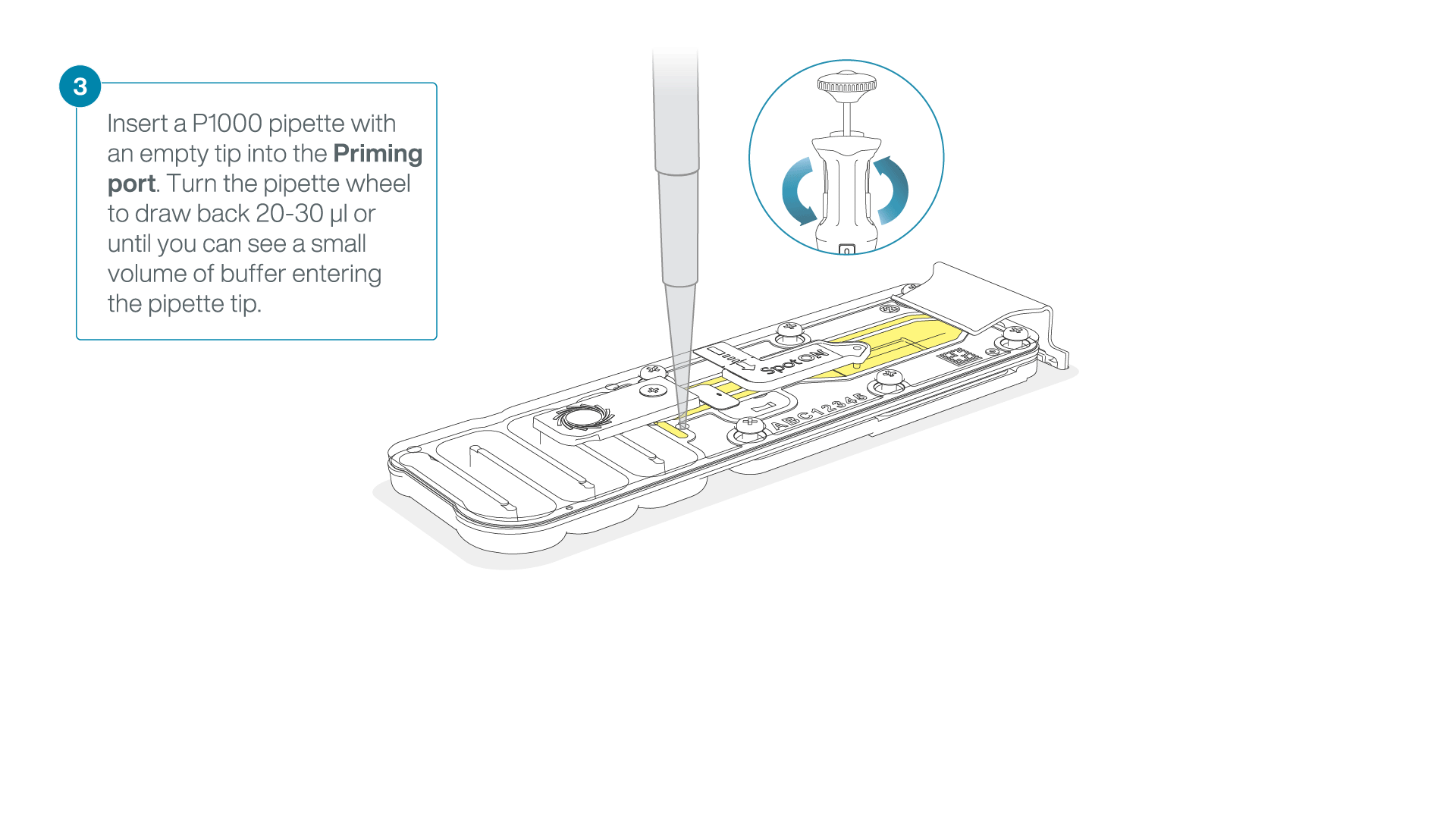
-
To prepare the flow cell priming mix with BSA, combine the following reagents in a 1.5 ml Eppendorf tube, and mix by inverting the tube and pipette mix at room temperature:
Reagent Volume Bovine Serum Albumin (BSA) at 50 mg/ml 5 µl Flush Tether UL (FTU) 30 µl Flow Cell Flush (FCF) 1170 µl Total 1205 µl -
Load 800 µl of the priming mix into the flow cell via the priming port, avoiding the introduction of air bubbles. Wait for five minutes.
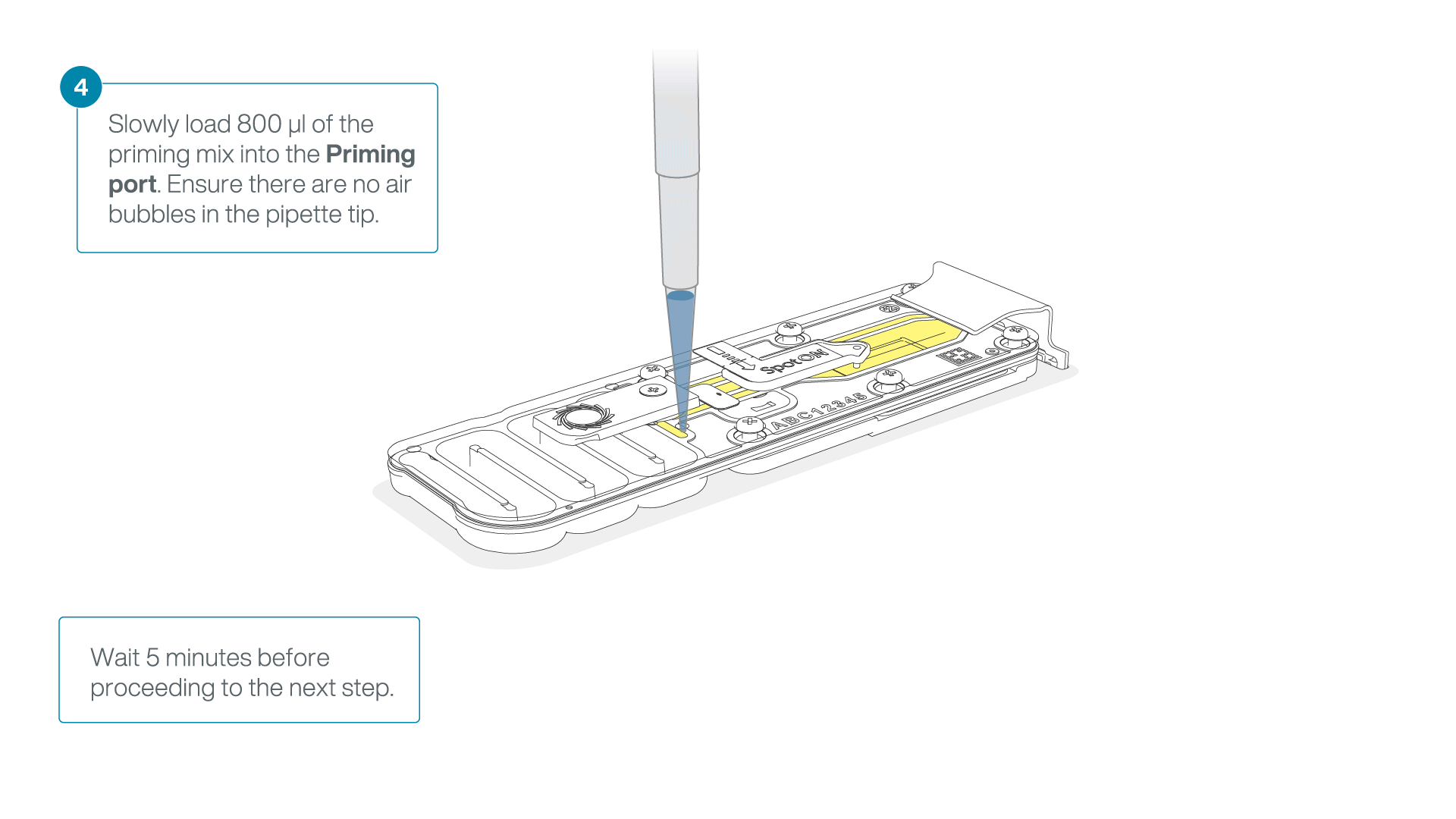
-
Complete the flow cell priming:
- Gently lift the SpotON sample port cover to make the SpotON sample port accessible.
- Load 200 µl of the priming mix into the flow cell priming port (not the SpotON sample port), avoiding the introduction of air bubbles.
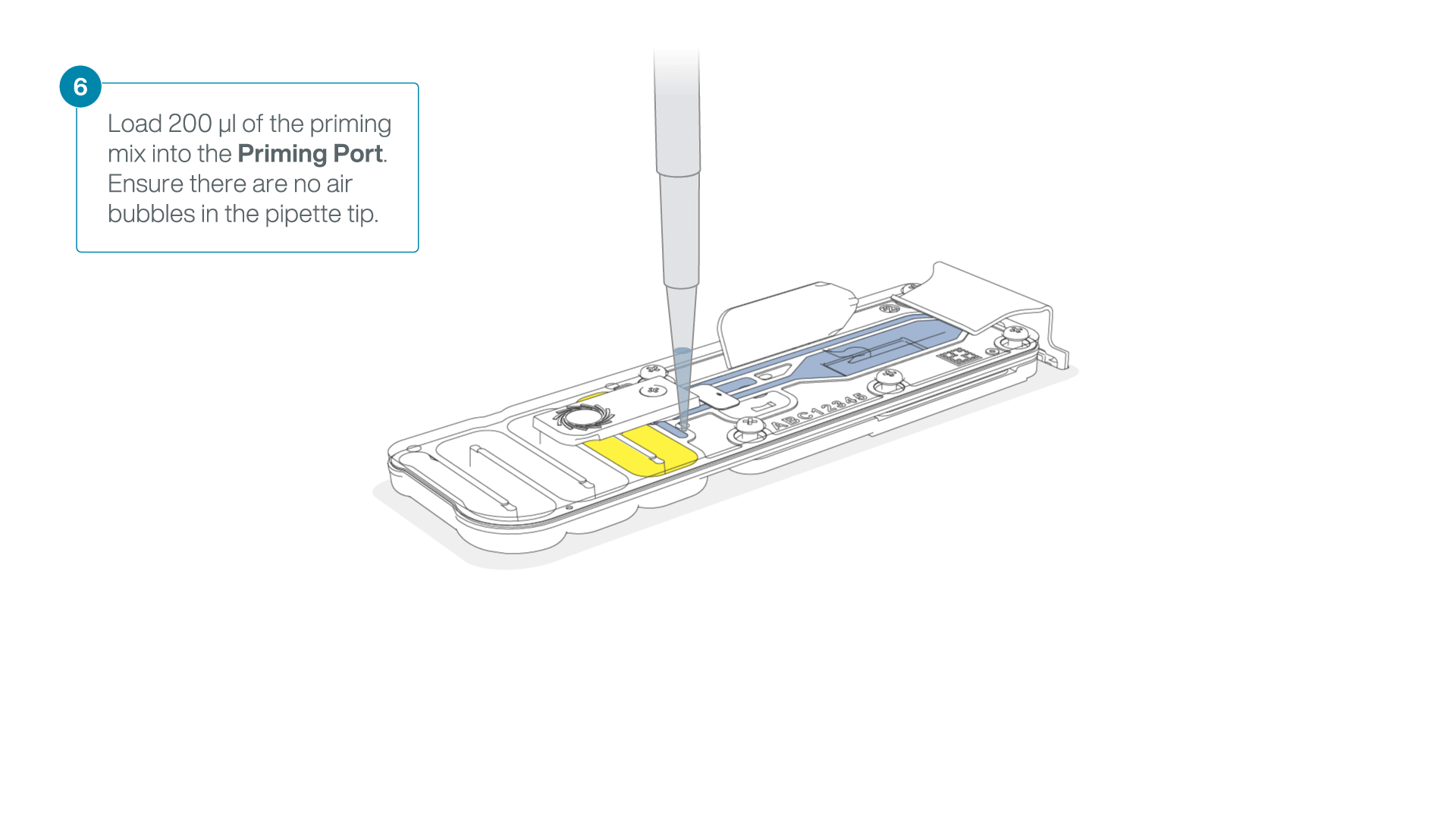
-
Ensure the SpotON port and Priming port covers of the flow cell are open in preparation for loading.
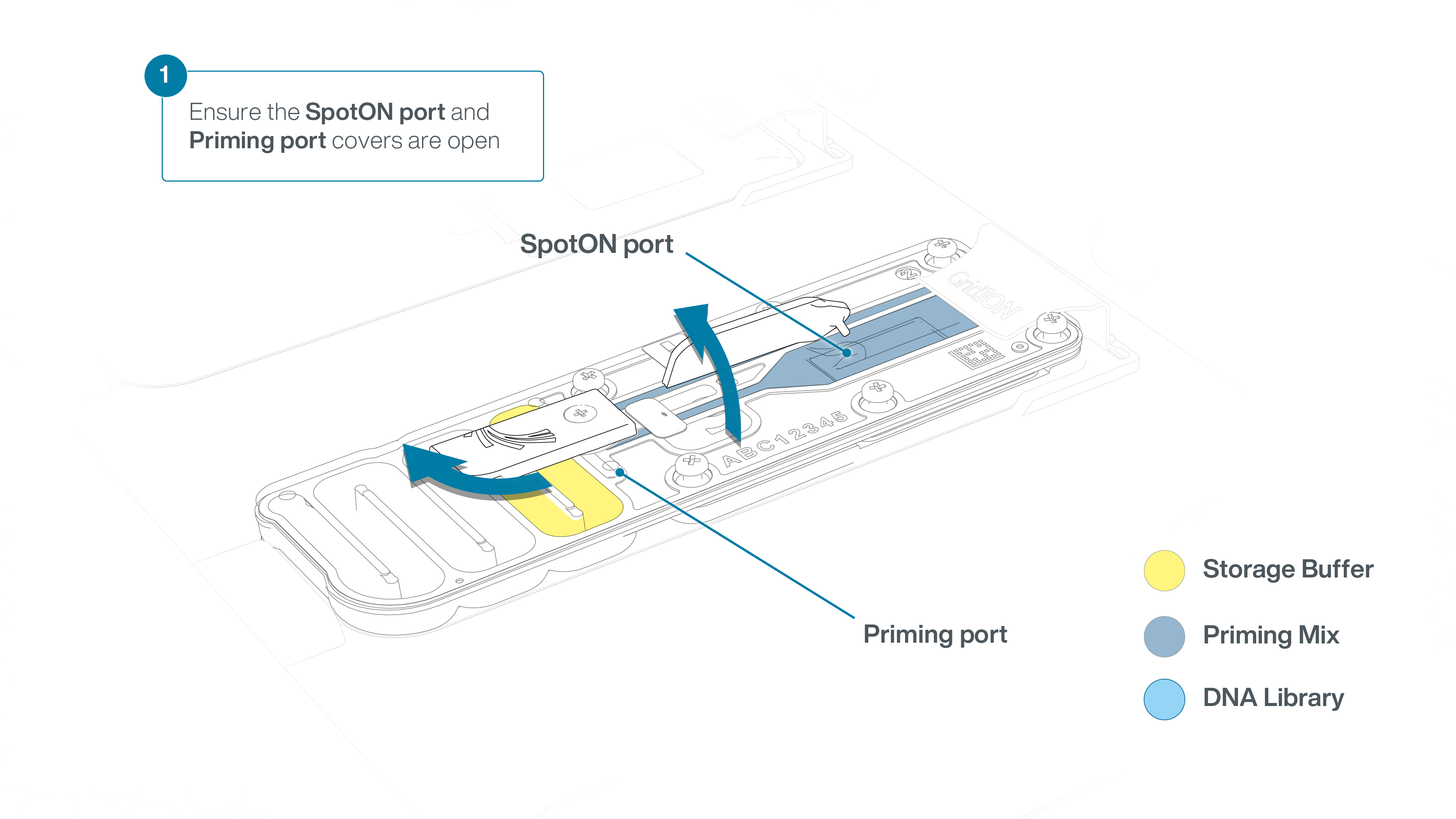
-
Using a wide-bore pipette tip, load the DNA library onto the SpotON port until 75 μl has been loaded.
Take care not to place the pipette tip directly onto/into the SpotON port as this could damage the array.
Allow the DNA library to flow through the SpotON port by waiting up to two minutes.
If the DNA library does not enter the SpotON port, apply negative pressure in the flow cell as explained further below.
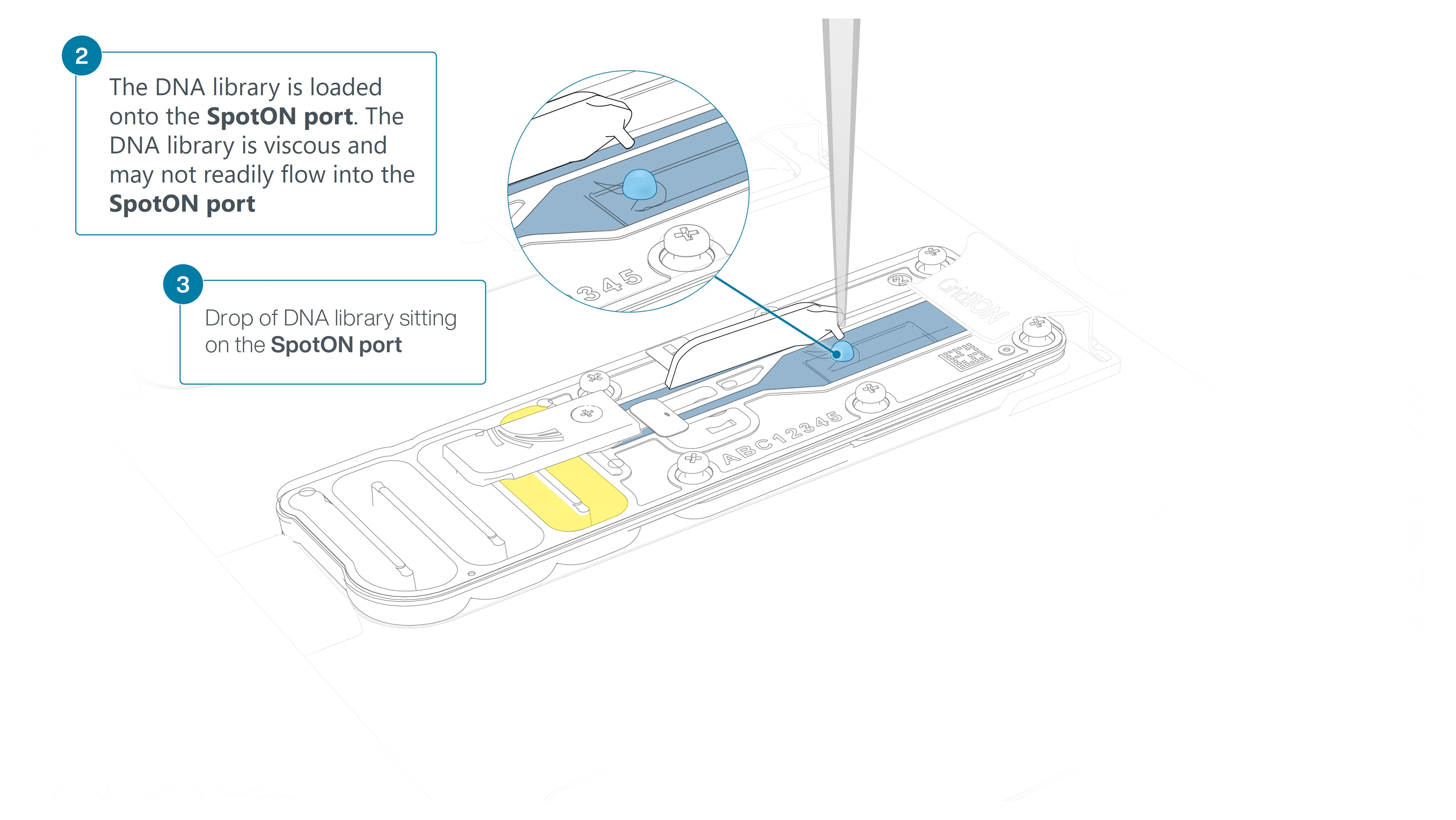
-
Cover Waste port 2 and the Priming port with clean, gloved fingers.
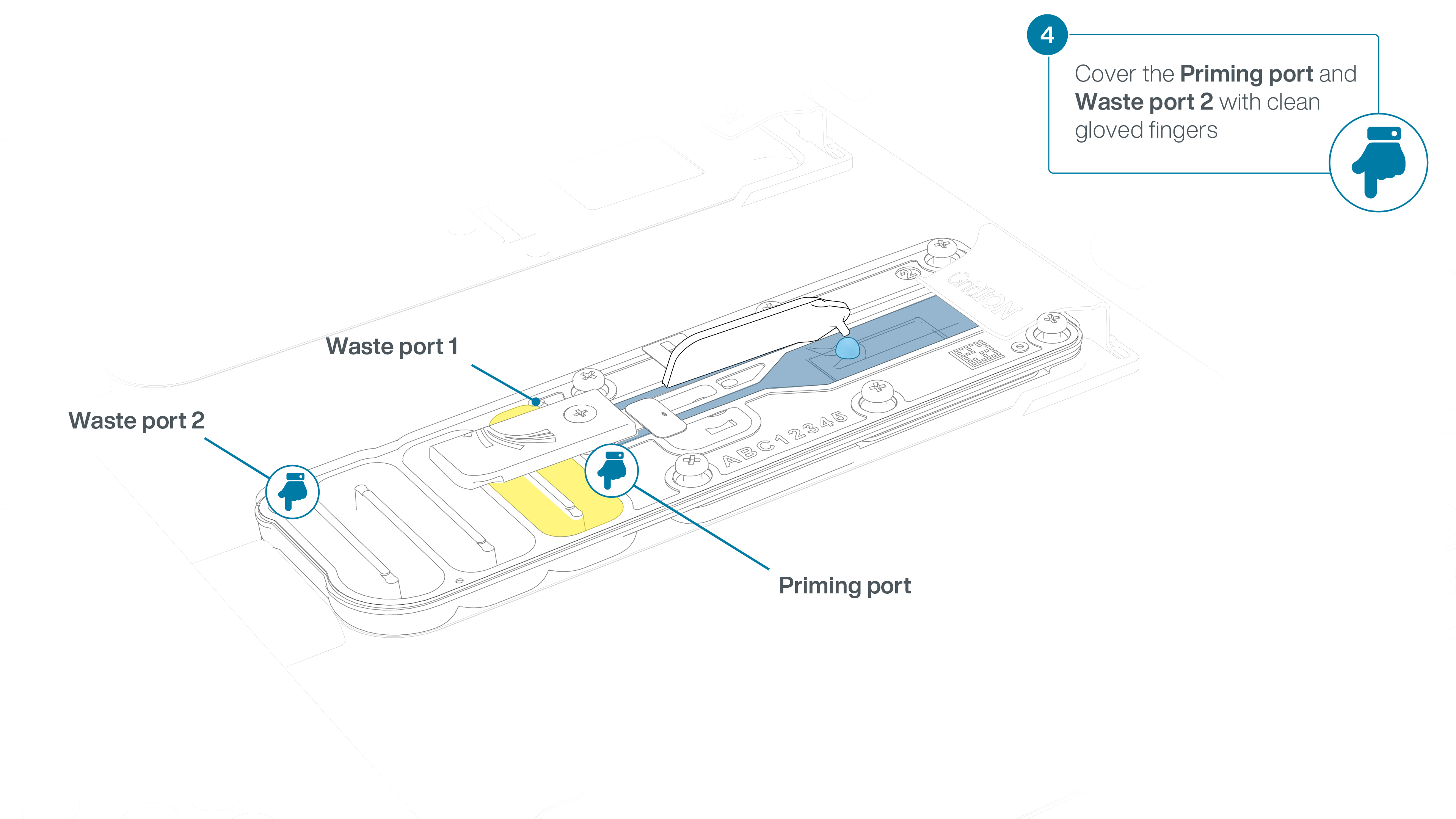
-
Using a fully depressed P200 pipette, insert the tip in Waste port 1 whilst Waste port 2 and the Priming port are covered.
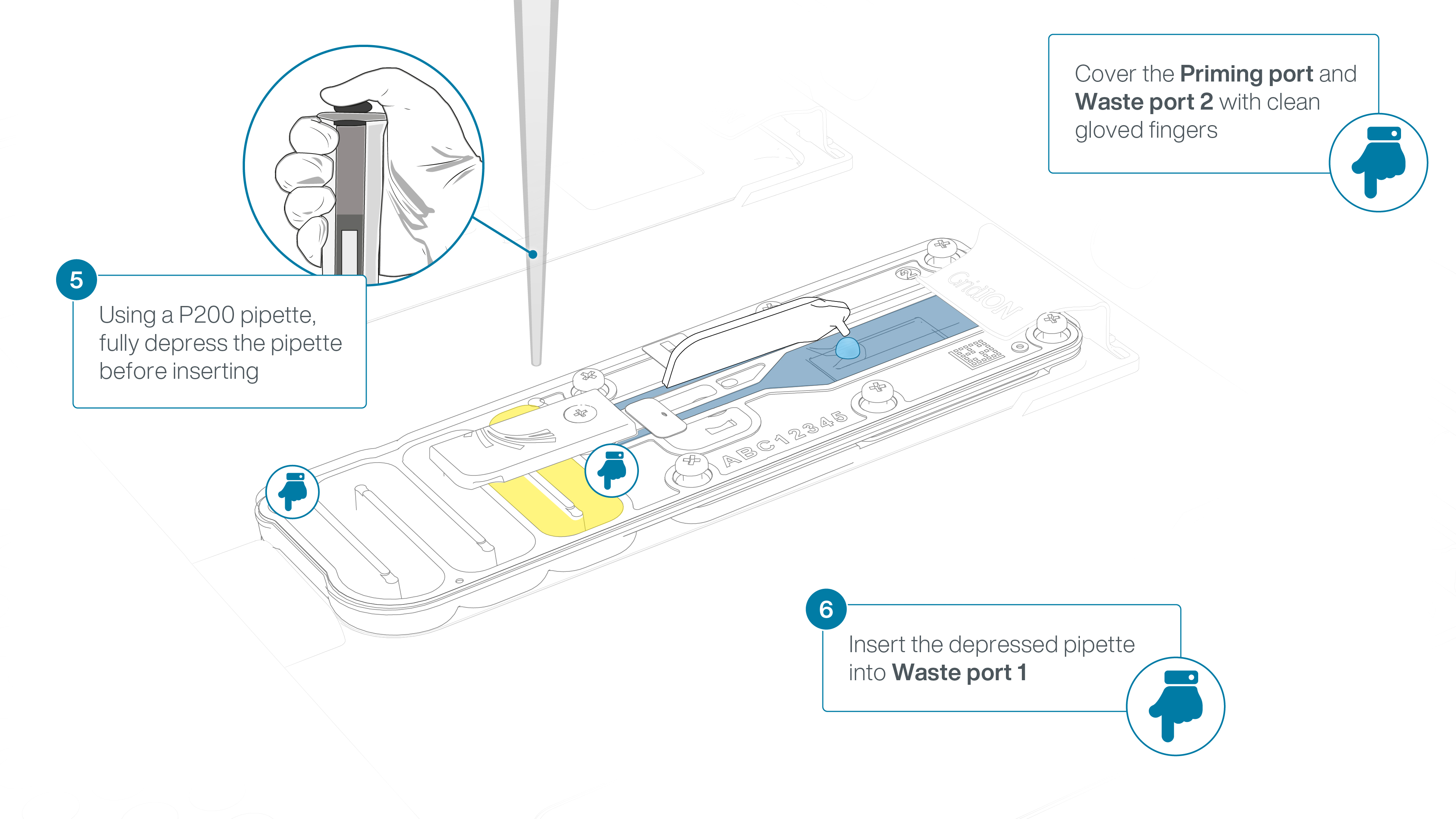
-
Very slowly aspirate to pull the DNA library into the SpotON sample port. Closely watch the DNA library on the SportON port and completely remove the pipette as soon as the library starts to be pulled into the port.
Note: Take care to not apply too much negative pressure too quickly to avoid bringing air bubbles into the flow cell. Air bubbles will cause irreversible damage to the flow cell.

-
Gently replace the SpotON sample port cover, making sure the bung enters the SpotON port and close the priming port.

-
Place the light shield onto the flow cell, as follows:
Carefully place the leading edge of the light shield against the clip.
Note: Do not force the light shield underneath the clip.Gently lower the light shield onto the flow cell. The light shield should sit around the SpotON cover, covering the entire top section of the flow cell.
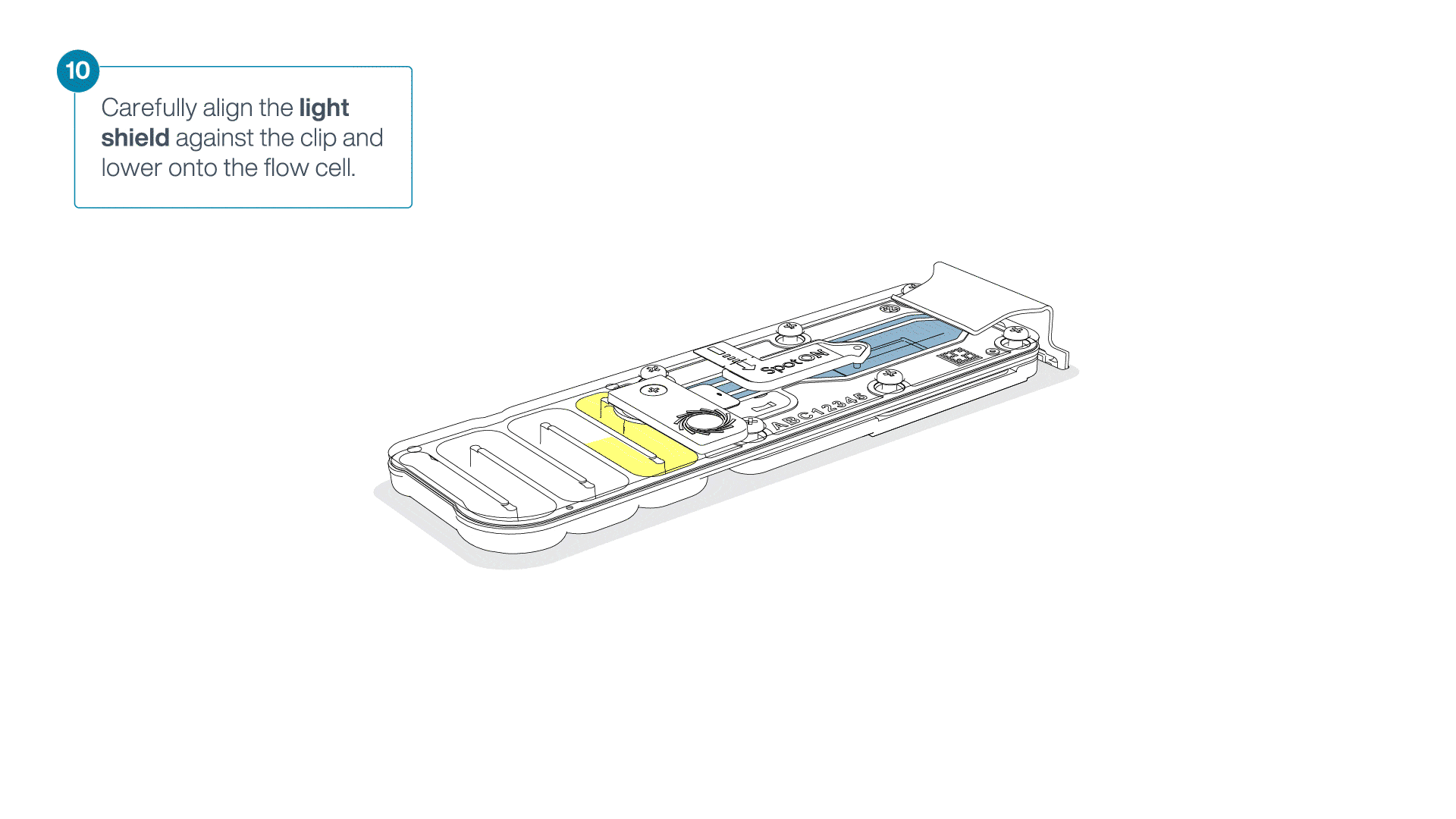
-
We recommend loading an ultra-long DNA library three times per flow cell to increase output.
A nuclease wash using the Flow Cell Wash Kit (EXP-WSH004) is required between each subsequent library load to recover channels and maximise sequencing output.
For MinION/GridION flow cells, there is enough library generated for six consecutive loads per reaction, using 33.8 µl of fresh library combined with 37.5 µl of Sequencing Buffer (SBU) and 3.7 µl of Loading Solution (LSU) before re-loading for further sequencing.
Please follow Flushing a MinION/GridION Flow Cell in the Flow Cell Wash Kit protocol for the nuclease wash instructions. To run another library straight away, follow the instructions below.
Reloading ultra-long DNA library on a MinION/GridION flow cell
Reloading ultra-long DNA library on a MinION/GridION flow cell
- Materials
-
- Flow Cell Wash Kit (EXP-WSH004)
- Flush Tether UL (FTU)
- Flow Cell Flush (FCF)
- Sequencing Buffer UL (SBU)
- Loading Solution UL (LSU)
- Consumables
-
- 1.5 ml Eppendorf DNA LoBind tubes
- Bovine Serum Albumin (BSA) (50 mg/ml) (e.g Invitrogen™ UltraPure™ BSA 50 mg/ml, AM2616)
- Equipment
-
- P1000 pipette and wide-bore pipette tips
- P200 pipette and wide-bore pipette tips
- P1000 pipette and tips
- P200 pipette and tips
- P20 pipette and tips
-
To run a second library of ultra-long DNA straight after flushing a flow cell, we recommend removing all fluid from the waste channel after each priming step.
-
Thaw the Sequencing Buffer UL (SBU), Loading Solution UL (LSU), Flush Tether UL (FTU) and one tube of Flow Cell Flush (FCF) at room temperature and mix by vortexing. Then spin down and place on ice.
-
In a new tube, prepare the DNA library for loading as follows. Use a wide-bore pipette tip for the addition of the DNA library:
Reagent Volume per flow cell Sequencing Buffer UL (SBU) 37.5 µl Loading Solution UL (LSU) 3.7 µl DNA library 33.8 µl Total 75 µl Note: Ensure the Sequencing Buffer UL (SBU) and Loading Solution UL (LSU) are thoroughly mixed by pipetting before the addition of the DNA library.
-
Gently mix the prepared DNA library by slowly pipetting ten times using a wide-bore pipette tip.
-
Incubate at room temperature for 30 minutes then gently mix by slowly pipetting with a wide-bore tip. Visually inspect to ensure the sample is homogenous.
-
Slide the priming port cover of the flow cell clockwise to open the priming port.
-
After opening the priming port, check for a small air bubble under the cover. Draw back a small volume to remove any bubbles:
- Set a P1000 pipette to 200 µl
- Insert the tip into the priming port
- Turn the wheel until the dial shows 220-230 µl, to draw back 20-30 µl, or until you can see a small volume of buffer entering the pipette tip
Note: Visually check that there is continuous buffer from the priming port across the sensor array.

-
To prepare the flow cell priming mix with BSA, combine the following reagents in a 1.5 ml Eppendorf tube, and mix by inverting the tube and pipette mix at room temperature:
Reagent Volume Bovine Serum Albumin (BSA) at 50 mg/ml 5 µl Flush Tether UL (FTU) 30 µl Flow Cell Flush (FCF) 1170 µl Total 1205 µl -
Load 800 µl of the priming mix into the flow cell via the priming port, avoiding the introduction of air bubbles. Wait for five minutes.

-
Close the priming port cover and ensure the SpotON sample port cover is closed.
-
Remove the waste buffer, as follows:
- Close the priming port and SpotON sample port cover, as indicated in the figure below.
- Insert a P1000 pipette into waste port 1 and remove the waste buffer.
Note: As both the priming port and SpotON sample port are closed, no fluid should leave the sensor array area.
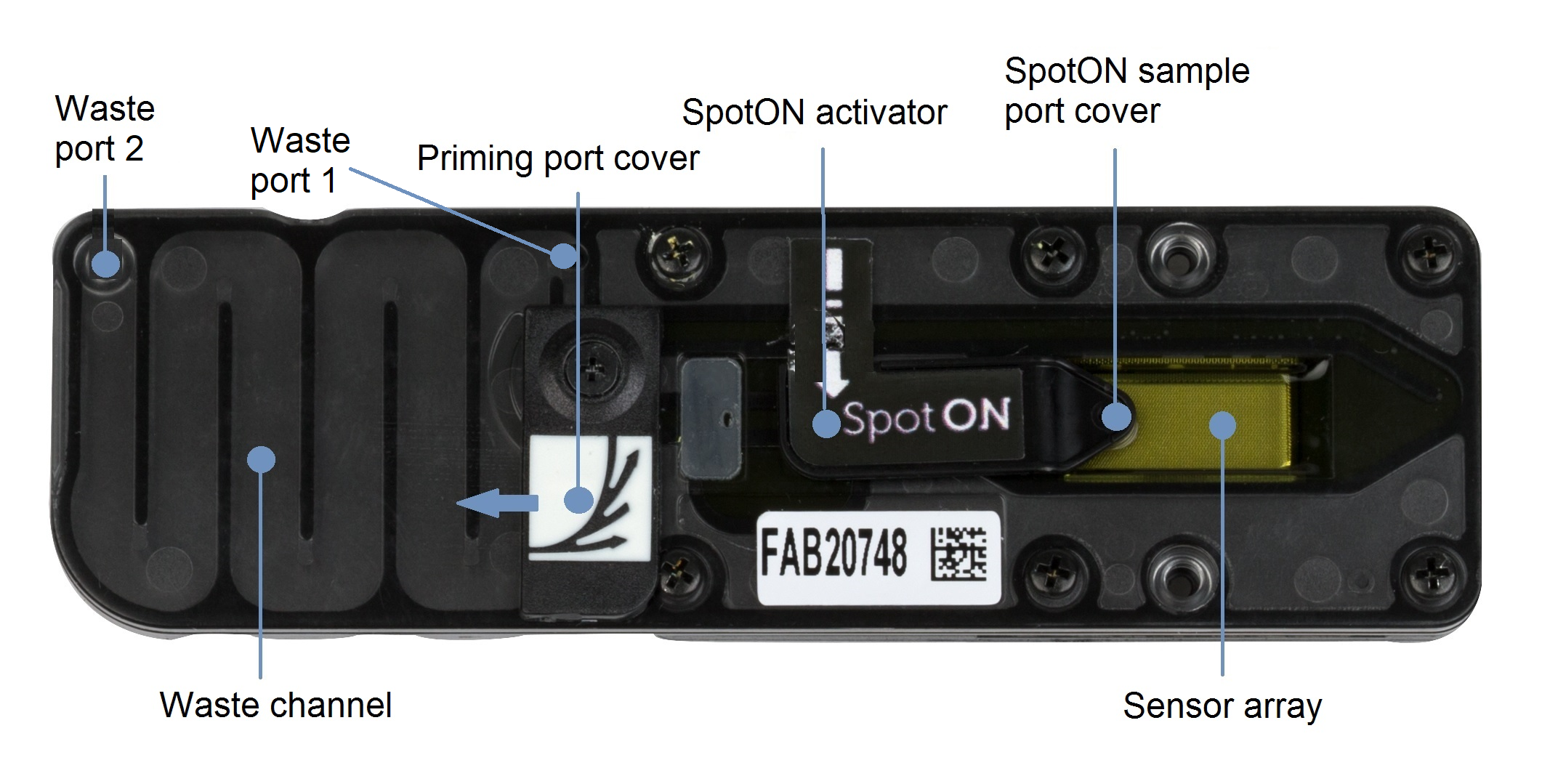
-
Slide open the priming port and load 200 µl of the priming mix into the flow cell via the priming port, avoiding the introduction of air bubbles.
-
Close the priming port and use a P1000 to remove all fluid from the waste channel through Waste Port 1.
-
Ensure the SpotON port and Priming port covers of the flow cell are open in preparation for loading.

-
Using a wide-bore pipette tip, load the DNA library onto the SpotON port until 75 μl has been loaded.
Take care not to place the pipette tip directly onto/into the SpotON port as this could damage the array.
Allow the DNA library to flow through the SpotON port by waiting up to two minutes.
If the DNA library does not enter the SpotON port, apply negative pressure in the flow cell as explained further below.

-
Cover Waste port 2 and the Priming port with clean, gloved fingers.
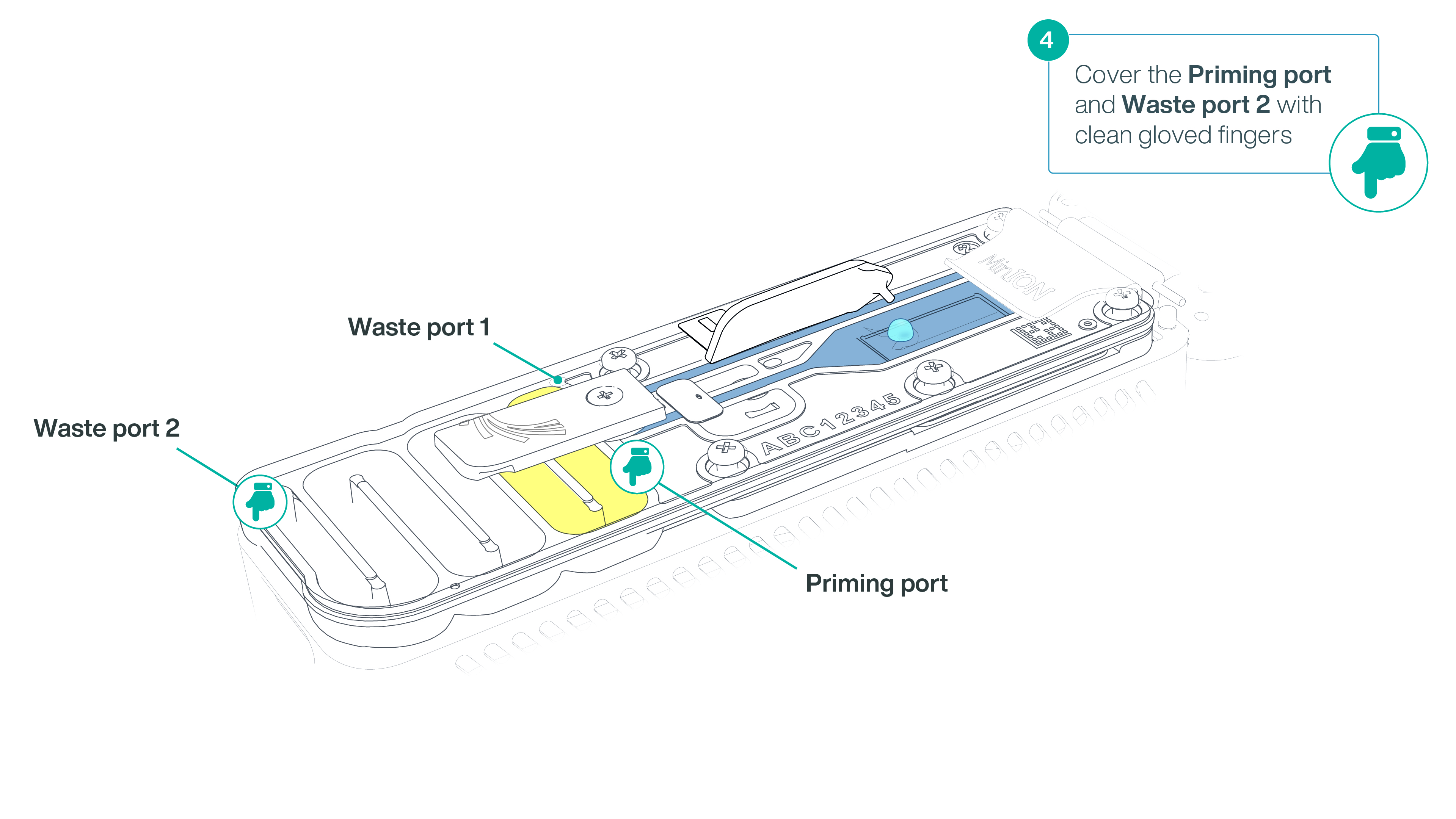
-
Using a fully depressed P200 pipette, insert the tip in Waste port 1 whilst Waste port 2 and the Priming port are covered.
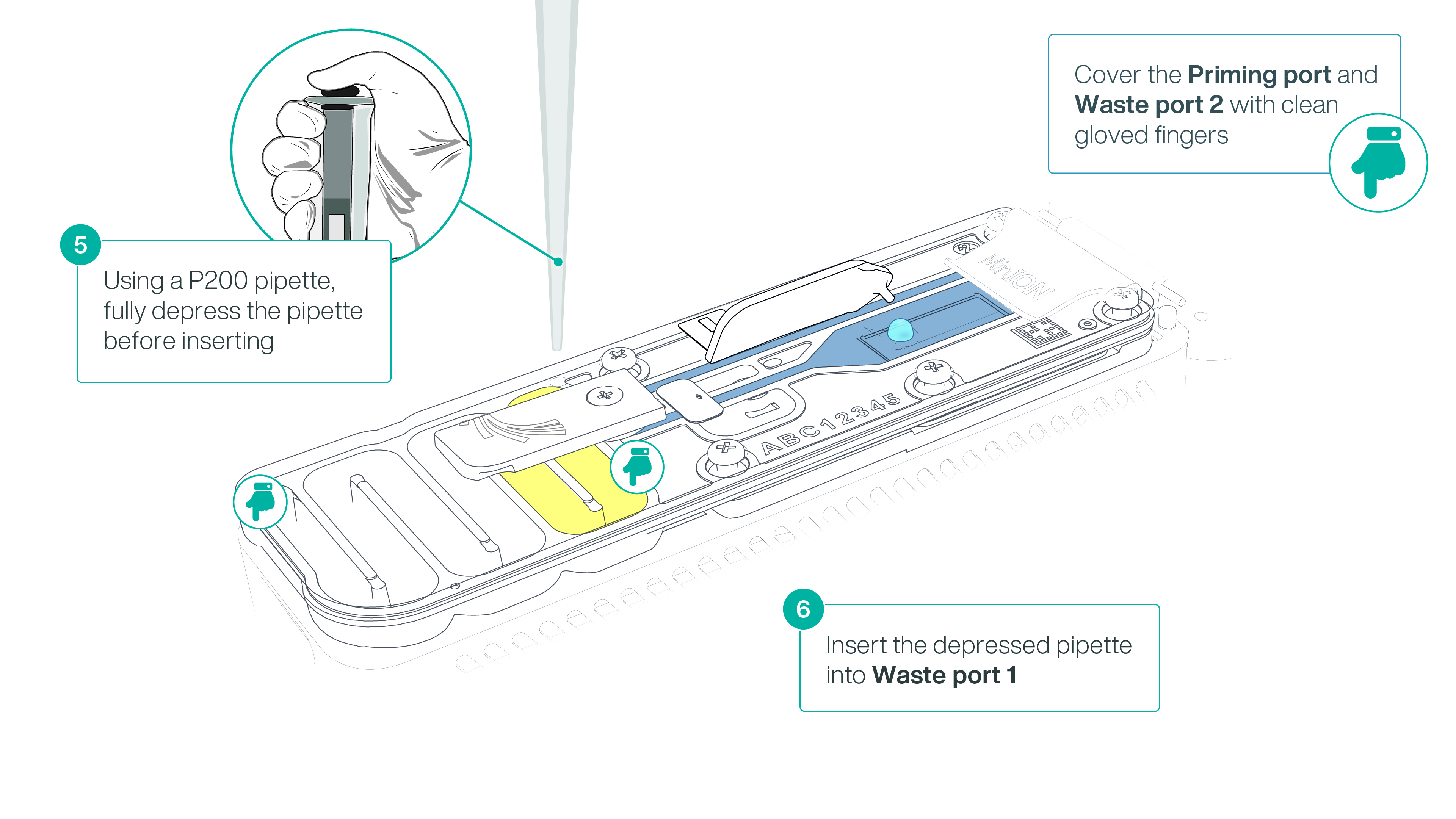
-
Very slowly aspirate to pull the DNA library into the SpotON sample port. Closely watch the DNA library on the SportON port and completely remove the pipette as soon as the library starts to be pulled into the port.
Note: Take care to not apply too much negative pressure too quickly to avoid bringing air bubbles into the flow cell. Air bubbles will cause irreversible damage to the flow cell.
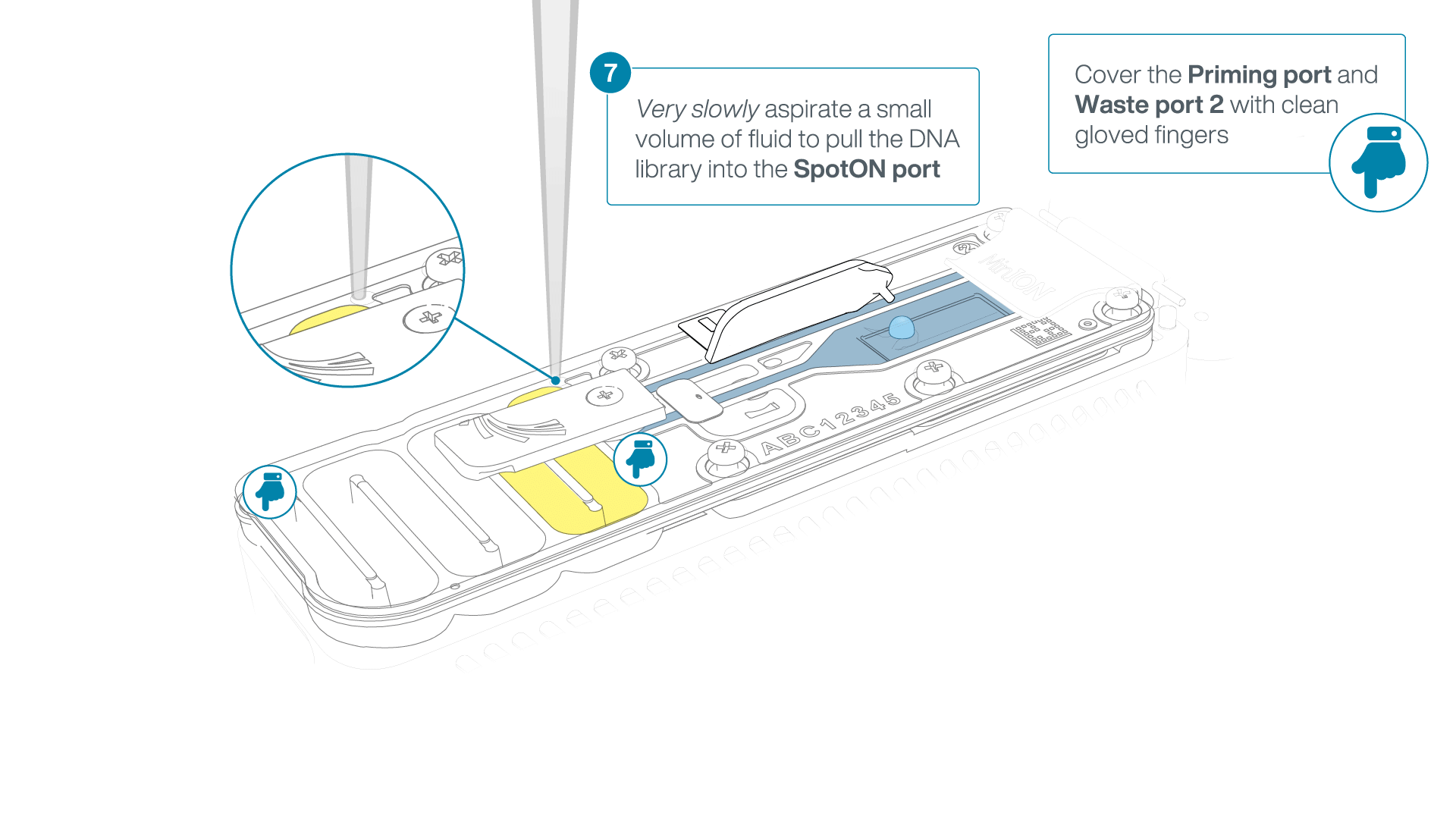
-
Gently replace the SpotON sample port cover, making sure the bung enters the SpotON port and close the priming port.

-
Place the light shield onto the flow cell, as follows:
Carefully place the leading edge of the light shield against the clip.
Note: Do not force the light shield underneath the clip.Gently lower the light shield onto the flow cell. The light shield should sit around the SpotON cover, covering the entire top section of the flow cell.

-
Once the flow cell is reloaded, resume the sequencing run on MinKNOW and trigger a pore scan.
To resume sequencing run, navigate to the Experiments page, click 'Resume' and select flow cell position.
To manually trigger a channel scan, click 'Start pore scan' and select flow cell position.
For further information, please see the MinKNOW protocol.
Resume run:
Pore scan:
Sequencing and data analysis
Data acquisition and basecalling
Data acquisition and basecalling
-
How to start sequencing
Once you have loaded your flow cell, the sequencing run can be started on MinKNOW, our sequencing software that controls the device, data acquisition and real-time basecalling. For more detailed information on setting up and using MinKNOW, please see the MinKNOW protocol.
MinKNOW can be used and set up to sequence in multiple ways:
- On a computer either directly or remotely connected to a sequencing device.
- Directly on a GridION or PromethION 24/48 sequencing device.
For more information on using MinKNOW on a sequencing device, please see the device user manuals:
- MinION Mk1B user manual
- MinION Mk1C user manual
- MinION Mk1D user manual
- GridION user manual
To start a sequencing run on MinKNOW:
1. Navigate to the start page and click Start sequencing.
2. Fill in your experiment details, such as name and flow cell position and sample ID.
3. Select the sequencing kit used in the library preparation on the Kit page.
4. Configure the sequencing and output parameters for your sequencing run or keep to the default settings on the Run configuration tab.
Note: If basecalling was turned off when a sequencing run was set up, basecalling can be performed post-run on MinKNOW. For more information, please see the MinKNOW protocol.
5. Click Start to initiate the sequencing run.
-
Data analysis after sequencing
After sequencing has completed on MinKNOW, the flow cell can be reused or returned, as outlined in the Flow cell reuse and returns section.
After sequencing and basecalling, the data can be analysed. For further information about options for basecalling and post-basecalling analysis, please refer to the Data Analysis document.
In the Downstream analysis section, we outline further options for analysing your data.
Flow cell reuse and returns
Flow cell reuse and returns
- Materials
-
- Flow Cell Wash Kit (EXP-WSH004)
-
After your sequencing experiment is complete, if you would like to reuse the flow cell, please follow the Flow Cell Wash Kit protocol and store the washed flow cell at +2°C to +8°C.
The Flow Cell Wash Kit protocol is available on the Nanopore Community.
-
Alternatively, follow the returns procedure to send the flow cell back to Oxford Nanopore.
Instructions for returning flow cells can be found here.
Downstream analysis
Downstream analysis
-
Post-basecalling analysis
There are several options for further analysing your basecalled data:
1. EPI2ME workflows
For in-depth data analysis, Oxford Nanopore Technologies offers a range of bioinformatics tutorials and workflows available in EPI2ME. The platform provides a vehicle where workflows deposited in GitHub by our Research and Applications teams can be showcased with descriptive texts, functional bioinformatics code and example data.
2. Research analysis tools
Oxford Nanopore Technologies' Research division has created a number of analysis tools, which are available in the Oxford Nanopore GitHub repository. The tools are aimed at advanced users, and contain instructions for how to install and run the software. They are provided as-is, with minimal support.
3. Community-developed analysis tools
If a data analysis method for your research question is not provided in any of the resources above, please refer to the resource centre and search for bioinformatics tools for your application. Numerous members of the Nanopore Community have developed their own tools and pipelines for analysing nanopore sequencing data, most of which are available on GitHub. Please be aware that these tools are not supported by Oxford Nanopore Technologies, and are not guaranteed to be compatible with the latest chemistry/software configuration.
Troubleshooting
Issues during library preparation
Issues during library preparation
-
Below is a list of the most commonly encountered issues, with some suggested causes and solutions.
We also have an FAQ section available on the Nanopore Community Support section.
If you have tried our suggested solutions and the issue still persists, please contact Technical Support via email (support@nanoporetech.com) or via LiveChat in the Nanopore Community.
-
Troubleshooting
Observation Comments and actions Low throughput 1. Vortex gently after adding the diluted Fragmentation Mix (FRA) to break up the largest fragments.
2. Ensure the diluted Fragmentation Mix (FRA) is thoroughly mixed with the gDNA.
3. Use less input material if the DNA library was too viscous to load onto the flow cell.DNA is too viscous and will not load onto a flow cell 1. Lower the input material to reduce the amount of gDNA going into the library preparation and reduce viscosity.
2. If DNA library will not load using the method outlined in this protocol, slowly pipette mix 5 times with a standard P200 pipette set to the full volume of the library and reload the flow cell.Read lengths are not long enough 1. Increase input material.
Note: Library viscosity increases with more gDNA.
2. Reduce volume of Fragmentation Mix (FRA) added to FRA Dilution Buffer (FDB) to avoid over-fragmentation of gDNA.
Note: We do not recommend diluting less than 2 µl Fragmentation Mix (FRA).
3. We recommend using PFGE to check the extracted gDNA is of ultra-high molecular weight (uHMW), thus capable of generating ultra-long read lengths.No sequencing output 1. Check gDNA has been recovered in library preparation using a NanoDrop spectrophotometer.
2. Check viscosity of the sample. The library should be viscous if it contains uHMW gDNA in this protocol.Aspirating supernatant when the DNA has precipitated Take care to not aspirate the DNA. Remove smaller volumes of supernatant incrementally to reduce the risk of aspirating the DNA. Mixing Mix slowly and carefully to prevent DNA shearing. Low vortexing can be used to mix at the expense of ultra-long reads. With vortexing, long read lengths of ~90 kb N50 can still be generated with improved outputs. No DNA recovered from the library preparation clean-up If the DNA is no longer viscous or the NanoDrop reading is low, DNA may have been lost during the clean-up step of the library preparation.
1. Ensure uHMW DNA is used or users risk DNA loss.
2. Take care to not aspirate the precipitated DNA during the clean-up step. To avoid this, remove smaller volumes of supernatant incrementally. Ensure as much supernatant is removed as possible.
Become a full member
Purchase a MinION Starter Pack from Avantor to get full community access and benefit from:
- News - hear about the latest product updates
- Posts - interact with thousands of nanopore users from around the globe
- Software - download the latest sequencing and analysis software
Already have a Nanopore Community account?
Log in hereNeed more help?
Request a call with our experts for detailed advice on implementing nanopore sequencing.
Request a callInterested in microbiology?
Visit our microbial sequencing spotlight page on vwr.com.
Microbial sequencing
















